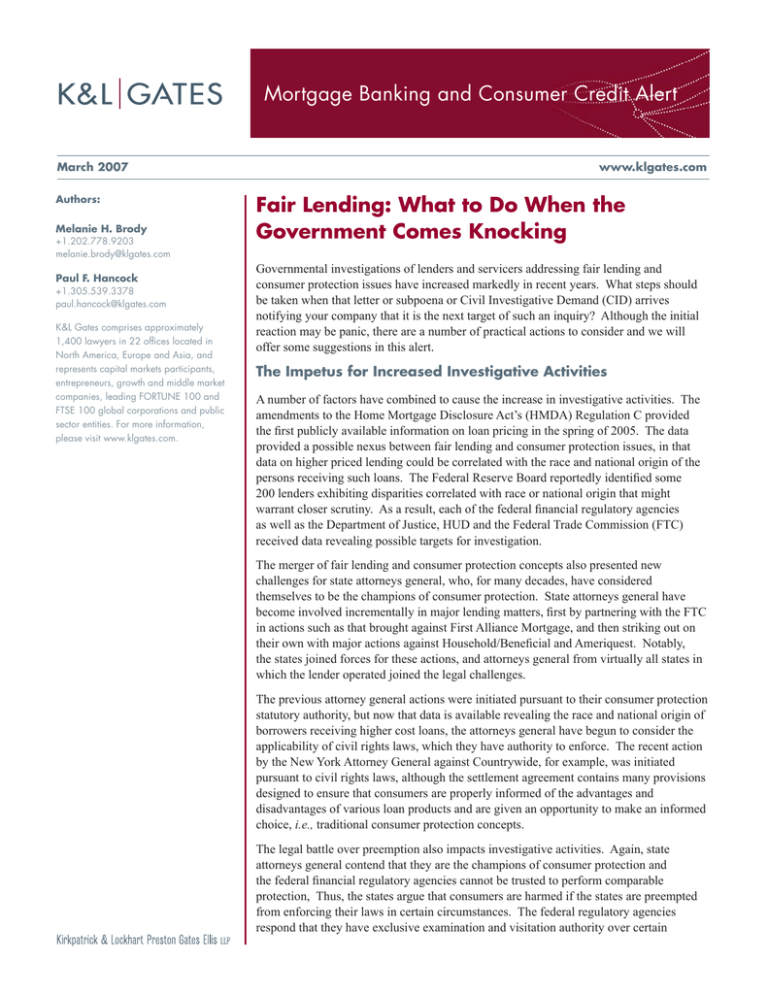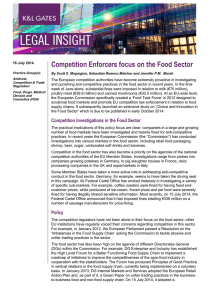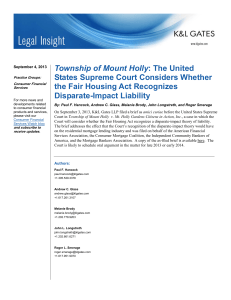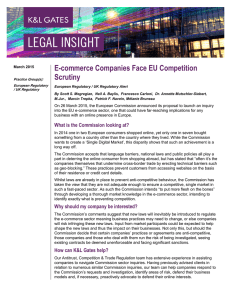
Mortgage Banking and Consumer Credit Alert
March 2007
Authors:
Melanie H. Brody
+1.202.778.9203
melanie.brody@klgates.com
Paul F. Hancock
+1.305.539.3378
paul.hancock@klgates.com
K&L Gates comprises approximately
1,400 lawyers in 22 offices located in
North America, Europe and Asia, and
represents capital markets participants,
entrepreneurs, growth and middle market
companies, leading FORTUNE 100 and
FTSE 100 global corporations and public
sector entities. For more information,
please visit www.klgates.com.
www.klgates.com
Fair Lending: What to Do When the
Government Comes Knocking
Governmental investigations of lenders and servicers addressing fair lending and
consumer protection issues have increased markedly in recent years. What steps should
be taken when that letter or subpoena or Civil Investigative Demand (CID) arrives
notifying your company that it is the next target of such an inquiry? Although the initial
reaction may be panic, there are a number of practical actions to consider and we will
offer some suggestions in this alert.
The Impetus for Increased Investigative Activities
A number of factors have combined to cause the increase in investigative activities. The
amendments to the Home Mortgage Disclosure Act’s (HMDA) Regulation C provided
the first publicly available information on loan pricing in the spring of 2005. The data
provided a possible nexus between fair lending and consumer protection issues, in that
data on higher priced lending could be correlated with the race and national origin of the
persons receiving such loans. The Federal Reserve Board reportedly identified some
200 lenders exhibiting disparities correlated with race or national origin that might
warrant closer scrutiny. As a result, each of the federal financial regulatory agencies
as well as the Department of Justice, HUD and the Federal Trade Commission (FTC)
received data revealing possible targets for investigation.
The merger of fair lending and consumer protection concepts also presented new
challenges for state attorneys general, who, for many decades, have considered
themselves to be the champions of consumer protection. State attorneys general have
become involved incrementally in major lending matters, first by partnering with the FTC
in actions such as that brought against First Alliance Mortgage, and then striking out on
their own with major actions against Household/Beneficial and Ameriquest. Notably,
the states joined forces for these actions, and attorneys general from virtually all states in
which the lender operated joined the legal challenges.
The previous attorney general actions were initiated pursuant to their consumer protection
statutory authority, but now that data is available revealing the race and national origin of
borrowers receiving higher cost loans, the attorneys general have begun to consider the
applicability of civil rights laws, which they have authority to enforce. The recent action
by the New York Attorney General against Countrywide, for example, was initiated
pursuant to civil rights laws, although the settlement agreement contains many provisions
designed to ensure that consumers are properly informed of the advantages and
disadvantages of various loan products and are given an opportunity to make an informed
choice, i.e., traditional consumer protection concepts.
The legal battle over preemption also impacts investigative activities. Again, state
attorneys general contend that they are the champions of consumer protection and
the federal financial regulatory agencies cannot be trusted to perform comparable
protection, Thus, the states argue that consumers are harmed if the states are preempted
from enforcing their laws in certain circumstances. The federal regulatory agencies
respond that they have exclusive examination and visitation authority over certain
Mortgage Banking and Consumer Credit Alert
types of entities and that they aggressively enforce
consumer protection laws, particularly in recent
years after it was decided that they have the authority
to enforce the Federal Trade Commission Act as
to the lenders that they regulate. Obviously, each
side—state and federal—seeks to prove its success
in enforcing consumer protection laws by conducting
investigations of lenders.
The FTC has perhaps the broadest investigative
authority in that it has authority to enforce both fair
lending laws (e.g., the Equal Credit Opportunity
Act (ECOA)) and consumer protection laws. The
agency is conducting investigations of possible
discrimination in loan pricing on the basis of race
or national origin (i.e., fair lending issues) as well
as continuing its traditional role of enforcing the
Federal Trade Commission Act.
The Department of Justice’s role is limited to fair
lending enforcement, but it is known that the agency
is conducting loan pricing investigations in addition
to diverse other issues that it has addressed, such as
racial redlining, marital status discrimination and
even sexual harassment in lending. Also, ECOA
requires the federal financial regulatory agencies
(i.e., the Federal Reserve Board, Office of the
Comptroller of the Currency (OCC), Office of Thrift
Supervision (OTS), Federal Deposit Insurance
Corporation (FDIC) and National Credit Union
Administration) to refer a lender to the Department
of Justice if the agency has reason to believe that
the lender is engaged in a pattern or practice of
unlawful discrimination. Loan pricing investigations
frequently implicate these types of issues.
HUD, with authority similar to the Department of
Justice, is conducting loan pricing investigations, as
well as pursuing issues referred by advocacy groups
such as loan eligibility criteria that have a disparate
impact on racial or ethnic minorities. These issues
raise particular concern for secondary market
investors who establish the eligibility criteria for
loans that they purchase.
It can reasonably be expected that this enforcement
surge will continue. A new round of HMDA data
became available in 2006, and lenders recently
have filed data that will be available this year. Loan
pricing remains an important enforcement priority
of both state and federal officials. The downturn in
the housing market, the cutback on nontraditional
mortgages, the recent advice on subprime lending,
and a Congress now controlled by Democrats will
add to the complexities. Advocates already contend,
for example, that persons have been steered to
nontraditional mortgages on the basis of race or
national origin, and investigations of these types of
claims will further merge the concepts of fair lending
with consumer protection.
Thus, the letter or subpoena can emanate from
a host of governmental agencies and can raise a
variety of issues. Every investigation is unique,
but there are a number of initial considerations and
decisions that will apply in most or all cases. The
discussion that follows will concentrate on loan
pricing investigations, primarily because those seem
to be the most common type of investigations being
conducted at the present time. The suggestions,
however, are readily transferable to any type of
fair lending or consumer protection investigation
involving a lender, servicer, investor or other type of
settlement service provider.
Suggested Steps to Follow When the
Letter Arrives
Analyze Scope of Inquiry
The obvious first step in dealing with any
governmental inquiry is to analyze the scope. In
particular, a lender should carefully review the letter
announcing the investigation to determine (i) the
precise subject matter being reviewed (e.g., fair
lending practices in general, decisioning, pricing,
product placement, other consumer protection issues,
or a combination thereof), (ii) the type of information
requested (e.g., electronic loan data, written policies
and procedures, rate sheets, underwriting guidelines,
organizational charts), and (iii) the time period in
question. From the outset, the lender should attempt
to determine what is being examined and what
information is being requested.
In many instances, the types of information and
data fields being requested by the agency will reveal
the issues they are exploring. In other instances, a
lender can only guess at the focus of the inquiry. For
example, even if the agency requested the type of
data that traditionally is used in the analysis of loan
pricing, it might remain unclear which loan products
March 2007 | 2
Mortgage Banking and Consumer Credit Alert
will be included in the analysis (e.g., conventional
or governmental; purchase or refinance) or the type
of discrimination that will be reviewed (e.g., race,
national origin, gender, age, marital status).
which the investigation is based—if the company
does not have qualified people on the defense team.
Sometimes in-house staff can provide the necessary
expertise, but in many instances they cannot.
Some governmental agencies will tell the lender the
issues that they are exploring and the methods for
doing so. Counsel, experienced in working with the
agencies, also are usually able to predict the focus of
the inquiry.
The overall size and composition of the team will
vary depending on the lender’s size, complexity
and resources. Generally, however, on major
matters such as loan pricing investigations, the
team will consist of a senior level executive (often
a lawyer), who will oversee the process and keep
other key executives informed of the progress of
the investigation; outside counsel, who generally
will work with the lender to develop strategy,
prepare responses, engage and work with statistical
consultants, and communicate with the investigating
agency; outside statistical consultant, who will
analyze loan data to assist outside counsel in
assessing whether the lender has pricing or other
disparities; and an internal employee who will
coordinate the gathering of data and information in
response to the request.
An immediate initial assessment should also include
an analysis of the potential risks presented to the
company by the investigation. Potential monetary
exposure and reputational risk should be evaluated.
Such an analysis might be imprecise at such an early
stage, but it is an important consideration in staffing
and allocating resources to the matter.
Identify and Engage Your Team
A lender facing a fair lending or consumer protection
investigation will need to assemble a response team
as quickly as possible.
An initial consideration in this process is whether
to retain outside counsel. Cost is an important
consideration and some lenders have thought that
their credibility with government agencies may be
enhanced if they appear without outside counsel. On
the other hand, they may be walking into a hornets’
nest if they are not experienced in dealing in matters
of the type under review. Particularly on matters
presenting major monetary or reputational risks,
lenders may benefit from counsel with experience
in the issues presented, and who have credibility
with the agency conducting the investigation.
Additionally, experienced outside counsel may be
of important assistance in developing the facts in
a manner that exonerates the company, or at least
minimizes the damage that the company otherwise
would suffer.
Statistical analyses are frequently an important
component of governmental investigations, and it is
useful to consider whether a statistician or economist
should be retained at an early stage. Again, expense
is a major consideration in addressing this issue. But
in the modern investigative era, most governmental
agencies are searching for data that can be analyzed
electronically, and it is difficult to even respond to
the data requests—let alone analyze the data upon
Deadlines for Replying to Requests
In most cases, a governmental agency conducting
an investigation will request a large volume of loan
data, documents and information in a fairly short
time frame. It is quite common for governmental
requests for information to seem overbroad to
lenders. From the governmental perspective, the
agencies are concerned that their specific requests
will be read to exclude information that might be
relevant. Thus, they tend to draft their requests
very broadly. A lender may view the request
as unnecessarily burdensome, and demanding
information that is not relevant to the issues under
review. Governmental agencies generally are
responsive to claims of undue and unnecessary
burden, and usually are willing to narrow the request
so long as they can be assured that the information
they feel they need will be included. Reasoned
discussions often resolve these issues.
It is important to gather the requested materials
carefully to ensure, among other matters, that all
relevant items are identified and produced, and that
nonresponsive and privileged materials are excluded
from the production. Gathering the electronic
loan data almost always presents a challenge and
often takes longer than the other materials. Most
March 2007 | 3
Mortgage Banking and Consumer Credit Alert
governmental agencies are willing to provide a
reasonable extension to allow the lender enough
time to prepare its initial response. It is advisable
to engage in discussions with the governmental
agency as soon as possible to discuss the scope of
the requests and the time that is reasonably necessary
to respond. The agencies become upset when the
lender calls shortly before the due date and requests
additional time primarily because the lender has not
yet devoted attention to the matter.
Determine Your Initial Strategy: The
Level of Cooperation
Often, governmental agencies will begin inquiries
with a request that a lender voluntarily submit certain
information. For example, although the FTC has
authority to issue CIDs compelling the production
of documents, data and information, the agency
will often begin an inquiry with a letter seeking a
voluntary submission. The Department of Justice
regularly sends letters of this type, largely because it
lacks the authority to issue investigative subpoenas
under the Fair Housing Act.
At the outset, a lender who has been targeted in
an investigation must decide whether to cooperate
or resist. Cooperating generally entails providing
the investigating agency with the information and
data they have requested in a format that they can
understand, answering questions to aid in their
analysis, and providing access to employees for
interviews or depositions. Although a cooperating
lender may request the agency to narrow its scope
of inquiry, decline to produce privileged materials,
request reasonable deadline extensions, etc., it
generally will provide the agency with the items
requested in a timely manner.
The benefits of cooperating are that it will allow
the parties to avoid contention early on, enable
the lender and its counsel to establish a cordial
relationship with the investigators and, ideally, allow
the lender to establish credibility and goodwill. Also,
a lender that fails to cooperate may receive process
that legally requires a response, such as an FTC
CID. Even the Department of Justice, which lacks
investigative subpoena power, can team with HUD,
which possesses that authority. Or worse yet, the
Department may decide to file suit based on limited
information, and use the discovery process to obtain
the information that it desires.
The obvious downside to cooperating early on
is that the information and data provided to the
investigating agency may be used to build a case
against the lender. Early cooperation could impair
the lender’s future use of certain legal defenses
(e.g., preemption) and, once an investigator gets
access to information and loan data, it can be used
against the lender.
Resisting an investigation typically involves
challenging the agency’s legal authority
(e.g., based on federal preemption), refusing to
provide information voluntarily (e.g., requiring
a subpoena) and declining to assist the agency in
understanding the information provided. The risks
of resistance are obvious, but the tactic has been
used by some to delay the process—in some cases
by years—and potentially enable the lender to avoid
the inquiry altogether. Resisting from the outset
also will allow the lender to avoid being viewed
as having waived its legal defenses if the agency
decides to pursue a claim. Of course, the tactic also
will establish a contentious atmosphere from the
beginning and, if efforts to resist are unsuccessful, it
will likely result in a more aggressive investigation
and perhaps a more aggressive prosecution.
In determining whether to cooperate or resist, a
lender will need to consider a variety of factors,
including the strength of its arguments for resisting,
and whether it has an ongoing relationship with the
investigating agency. The consequences of resisting
also need to be evaluated carefully; for example,
lenders may be more likely to display a higher level
of cooperation with their primary regulators than on
inquiries from others. A lender also would consider
whether it has a strong substantive defense to the
issues under investigation. For instance, if a lender
knows that credit and collateral factors explain
disparities in its HMDA data, it may decide to
cooperate in a pricing case, even if the investigator’s
jurisdiction is questionable.
Assemble Data, Documents and
Information
Assuming a lender has opted to cooperate, it is
important to begin assembling the data, documents
and information requested as quickly as possible.
Identifying, gathering and preparing information
and loan data for production is time-consuming and
almost always takes longer than anticipated.
March 2007 | 4
Mortgage Banking and Consumer Credit Alert
It is advisable to give consideration to the accuracy
and completeness of the data being produced. As
noted earlier, governmental agencies are frequently
searching for data that is available in electronic
format. Electronically maintained data, however,
may not accurately reflect the information in the loan
file itself. For example, a borrower’s debt ratios
may change from the initial application to the final
underwriting decision, as a result of verification
of income and debts, but it is not uncommon for a
lender’s electronic data to contain ratios that were not
final. Other important data elements may be missing
from the electronic data simply because it was not
inputted by the responsible official. The accuracy
or completeness of all electronic information may
not be of importance for the normal operation of the
business, but it may lead to false conclusions by the
governmental agency that could cause severe injury
to the company.
If the review reveals inaccuracies or incompleteness
of data, it may be appropriate to so advise the
government officials. In some circumstances, it may
be necessary for the lender or the government agency
to turn to the loan files for accurate information.
Upon resolution of such issues, a lender will need to
make sure that it has identified all of the information
that is responsive to the agency’s request, while
ensuring that it is not inadvertently providing
materials that go beyond the scope of the request.
The proposed production also must be reviewed
carefully to ensure that no privileged information is
inadvertently disclosed.
Assess Potential Exposure Based Upon
Materials and Data Produced
An issue facing the lender is whether to analyze
the materials and data being produced to measure
its potential exposure, or simply wait until the
agency identifies a potential problem. With the
agency investigation frequently based on a statistical
analysis, resource and expense considerations are
relevant. In most instances, governmental agencies
will afford lenders an opportunity to respond to the
results of the investigation. Thus, some may choose
to await those results before incurring the expense of
analysis. The downside of this approach is that the
agencies often afford a short time for a response and
are frequently hardened in their opinion by the time
they reveal the results of the investigations.
Thus, the preferable approach, resources permitting,
is to conduct your own analysis of the data and
assess legal risk. In statistical cases, this usually
requires engaging an experienced and qualified
consultant to perform a statistical analysis of
loan data to determine, for example, the extent to
which price disparities are present. The consultant
should be engaged by a lawyer—ideally outside
counsel (although in-house counsel can handle the
engagement if necessary)—and the work should be
performed under attorney-client privilege. Although
the lender ultimately may choose to disclose its
pricing analysis to the investigating agency, at the
outset, the purpose of the analysis is to support the
lender’s lawyers’ efforts to render legal advice. As
such, the work should be treated as privileged unless
and until a decision is made to disclose it.
Some lenders perform statistical analyses using
internal resources, but in most cases it is preferable
to engage an outside consultant to perform the work.
Economists experienced in analyzing mortgage loan
data typically are familiar with the types of analyses
and methodologies that the governmental agencies
use, and will perform the same types of tests on
the lender’s data that the government is likely
to perform. Economists also will work with the
lender’s lawyers to develop the most appropriate way
to analyze the lender’s data given the lender’s scope
of operations, product mix and pricing practices.
Although most current mortgage loan pricing
investigations are centered around a statistical
analysis of the lender’s loan data, it also is critical to
review other materials, including a lender’s product
descriptions, underwriting policies, rate sheets,
originator compensation plans, fair lending training
materials and fair lending complaint/litigation logs.
These materials will provide information necessary
to properly analyze loan data. For instance, to
accurately determine why one group of borrowers
appears to pay higher prices than another, it is critical
to fully understand how the lender establishes the
price on any given loan. This will require a review
of rate sheets, which show the interest rate and point
combinations for various borrower and transaction
characteristics, as well as upward and downward
March 2007 | 5
Mortgage Banking and Consumer Credit Alert
price adjustments for certain loan features. It also
is essential to understand how loan officers are
compensated, including whether and how much
discretion they have for granting price exceptions
and charging overages.
A review of materials also is important for
identifying any evidence of overt discrimination.
For example, some recent complaints have been
based on published price sheets containing allegedly
discriminatory eligibility criteria. Finally, a lender
that has strong fair lending policies and procedures,
price monitoring programs, etc., can use these
materials to demonstrate a commitment to fair
lending compliance.
Develop Your Defense Without Being
Limited by the Materials and Data
Requested by the Agency
It is important to understand that a governmental
investigation is designed to obtain sufficient
information to allege that a lender has violated
the law. Some governmental agencies have lower
thresholds of proof for filing claims than others. But
all of the agencies are limited to the information
that they can acquire by voluntary cooperation or
compelled production. In virtually all circumstances,
however, the investigating agency, even at the close
of the investigation, will not have as thorough an
understanding of the company’s operations as the
company does itself.
A targeted lender has the ability to dig much deeper
into the facts than does the investigating agency.
Lenders certainly view the investigative process as a
major intrusion, but investigating agencies view it as
very tedious and complicated, and believe it difficult
to obtain all of the information necessary to make an
informed decision.
The lender’s defense team has access to all of the
company’s records, not merely the records that the
agency requested. The defense team has much easier
access to employees who are able to give meaning to
data as well as to provide crucial information that is
not reflected in either electronic data or loan files.
The crucial issue for the defense team, therefore,
is to decide what type of analysis it will perform to
demonstrate to the agency that a legal violation has
not occurred. That might result in a battle among
statisticians as to the appropriate factors to consider
in statistical modeling.
A statistical analysis might reveal disparities that
are unexplained by the model, and thus allegedly
support an assumption that the disparities result from
unlawful considerations. In some circumstances,
a lender will challenge the agency’s modeling and
demonstrate that proper modeling removes, or at
least narrows, the disparities.
It is equally important, however, not to leave
the issue of a legal violation to the statisticians.
Statistics are often blind to reality, which is why
responsible enforcement officials have generally
examined loan files to determine if the statistical
targeting accurately predicted the victims of unlawful
conduct. Unfortunately, governmental agencies
seem to be increasing their reliance on statistics,
and thus, when the methodology cannot be credibly
challenged, it is even more important for the lender
to search for explanations for disparities that do not
implicate statutes on which the agency relies. The
lending process is exceedingly complex and no
one model can accurately capture all of the factors
that are considered in the lender’s decision-making
process.
The challenge for the defense team is to dig deeper
than the investigating agency has dug. Again, your
team has better access to data and witnesses, and
what primarily is needed is a thoughtful and critical
analysis of the totality of circumstances that are
relevant to the inquiry. You may be challenged in
developing facts that had not been considered before
or in using data sources that had not been previously
used for this purpose. Relevant information may be
in the hands of persons who are normally outside
of the decision-making structure. The challenge, at
this stage, is by no means easy, and it may lead to an
ultimate conclusion that the enforcement agency is
correct in its charges. Just as likely, however, it may
lead to a conclusion that the charges are not correct,
and the intense review will allow you to present the
information that will avoid a legal challenge.
Conclusion
These suggestions may provide some guidance
for the increasing number of lenders facing
governmental investigations. We emphasize,
March 2007 | 6
Mortgage Banking and Consumer Credit Alert
however, that each investigation is unique, and there
is no one-size-fits-all response. Rather, a great deal
of thinking and analysis is required. The overall goal
is to take the appropriate action to properly defend
your company, ensure that all facts relevant to the
company’s defense are uncovered and considered,
and to avoid, or at least minimize, the injury to the
company that might otherwise result.
Please also review recent K&L Gates’ client alerts
about Countrywide Home Loans, Inc’s settlement
with the New York State Attorney General and
Ameriquest Mortgage Company’s settlement with
state attorneys general.
If you have any questions, please call either Paul
F. Hancock at 305-539-3378, Melanie Brody at
202-778-9203, or any other member of K&L Gates’
mortgage banking/consumer finance group. Paul
directed the fair lending enforcement program
of the Department of Justice for many years and
subsequently served as Deputy Attorney General
in Florida, where he enforced both fair lending and
consumer protection laws. In private practice, he
has represented lenders facing investigations by
the Department of Justice, the FTC, the federal
financial regulatory agencies and state attorneys
general. Melanie has handled fair lending pricing
investigations by the Department of Justice, HUD,
the Federal Reserve Board, the OCC, the New York
State Attorney General and state mortgage banking
regulators. She also has developed retail and whole
mortgage loan price monitoring programs and other
fair lending compliance programs for banks, large
national lenders and smaller regional lenders.
March 2007 | 7
Mortgage Banking and Consumer Credit Alert
MORTGAGE BANKING AND CONSUMER CREDIT PRACTICE
For more information, please visit our website at www.klgates.com or contact one of the lawyers listed below.
ATTORNEYS
Laurence E. Platt
Phillip L. Schulman
Costas A. Avrakotos
Melanie Hibbs Brody
Steven M. Kaplan
Jonathan Jaffe
H. John Steele
R. Bruce Allensworth
Irene C. Freidel
Nanci L. Weissgold
Paul F. Hancock
Phillip John Kardis II
Stephen E. Moore
Stanley V. Ragalevsky
Rebecca H. Laird
Ira L. Tannenbaum
Eric J. Edwardson
Holly K. Towle
David L. Beam
Emily J. Booth
Krista Cooley
David Keith Gaston
Anthony C. Green
Laura A. Johnson
Kris D. Kully
Drew A. Malakoff
David G. McDonough, Jr.
Erin Murphy
202.778.9034
202.778.9027
202.778.9075
202.778.9203
202.778.9204
415.249.1023
202.778.9489
617.261.3119
617.951.9154
202.778.9314
305.539.3378
202.778.9401
617.951.9191
617.951.9203
202.778.9038
202.778.9350
202.778.9387
206.370.8334
202.778.9026
202.778.9112
202.778.9257
202.778.9061
202.778.9893
202.778.9249
202.778.9301
202.778.9086
202.778.9207
415.249.1038
larry.platt@klgates.com
phil.schulman@klgates.com
costas.avrakotos@klgates.com
melanie.brody@klgates.com
steven.kaplan@klgates.com
jonathan.jaffe@klgates.com
john.steele@klgates.com
bruce.allensworth@klgates.com
irene.freidel@klgates.com
nanci.weissgold@klgates.com
paul.hancock@klgates.com
phillip.kardis@klgates.com
stephen.moore@klgates.com
stan.ragalevsky@klgates.com
rebecca.laird@klgates.com
ira.tannenbaum@klgates.com
eric.edwardson@klgates.com
holly.towle@klgates.com
david.beam@klgates.com
emily.booth@klgates.com
krista.cooley@klgates.com
david.gaston@klgates.com
anthony.green@klgates.com
laura.johnson@klgates.com
kris.kully@klgates.com
drew.malakoff@klgates.com
david.mcdonough@klgates.com
erin.murphy@klgates.com
Lorna M. Neill
Stephanie C. Robinson
Kerri M. Smith
Holly M. Spencer
Erin E. Troy
Staci P. Newman
Elwood F. Collins
Steve H. Epstein
Nadya N. Fitisenko
Brian M. Forbes
Thomas J. Poletti
Thomas C. Russler
202.778.9216
202.778.9856
202.778.9445
202.778.9853
202.778.9384
202.778.9452
212.536.4005
212.536.4830
617.261.3173
617.261.3152
310.552.5045
212.536.4068
lorna.neill@klgates.com
stephanie.robinson@klgates.com
kerri.smith@klgates.com
holly.spencer@klgates.com
erin.troy@klgates.com
staci.newman@klgates.com
elwood.collins@klgates.com
steve.epstein@klgates.com
nadya.fitsenko@klgates.com
brian.forbes@klgates.com
thomas.poletti@klgates.com
thomas.russler@klgates.com
DIRECTOR OF LICENSING
Stacey L. Riggin
202.778.9202 stacey.riggin@klgates.com
REGULATORY COMPLIANCE ANALYSTS
Dana L. Lopez
Nancy J. Butler
Marguerite T. Frampton
Jeffrey Prost
Allison A. Rosenthal
Brenda R. Kittrell
Joann Kim
Teresa Diaz
Robin L. Gieseke
Dameian L. Buncum
Jennifer Early
202.778.9383
202.778.9374
202.778.9253
202.778.9364
202.778.9894
202.778.9049
202.778.9421
202.778.9852
202.778.9481
202.778.9093
202.778.9291
dana.lopez@klgates.com
nancy.butler@klgates.com
marguerite.frampton@klgates.com
jeffrey.prost@klgates.com
allison.rosenthal@klgates.com
brenda.kittrell@klgates.com
joann.kim@klgates.com
teresa.diaz@klgates.com
robin.gieseke@klgates.com
dameian.buncum@klgates.com
jennifer.early@klgates.com
K&L Gates comprises multiple affiliated partnerships: a limited liability partnership with the full name Kirkpatrick & Lockhart Preston Gates Ellis
LLP qualified in Delaware and maintaining offices throughout the U.S., in Berlin, and in Beijing (Kirkpatrick & Lockhart Preston Gates Ellis LLP
Beijing Representative Office); a limited liability partnership (also named Kirkpatrick & Lockhart Preston Gates Ellis LLP) incorporated in England
and maintaining our London office; a Taiwan general partnership (Kirkpatrick & Lockhart Preston Gates Ellis) which practices from our Taipei
office; and a Hong Kong general partnership (Kirkpatrick & Lockhart Preston Gates Ellis, Solicitors) which practices from our Hong Kong office.
K&L Gates maintains appropriate registrations in the jurisdictions in which its offices are located. A list of the partners in each entity is available
for inspection at any K&L Gates office.
This publication/newsletter is for informational purposes and does not contain or convey legal advice. The information herein should not be used
or relied upon in regard to any particular facts or circumstances without first consulting a lawyer.
Data Protection Act 1998—We may contact you from time to time with information on Kirkpatrick & Lockhart Preston Gates Ellis LLP seminars
and with our regular newsletters, which may be of interest to you. We will not provide your details to any third parties. Please e-mail london@
klgates.com if you would prefer not to receive this information.
©1996-2007 Kirkpatrick & Lockhart Preston Gates Ellis LLP. All Rights Reserved.
March 2007 | 8






